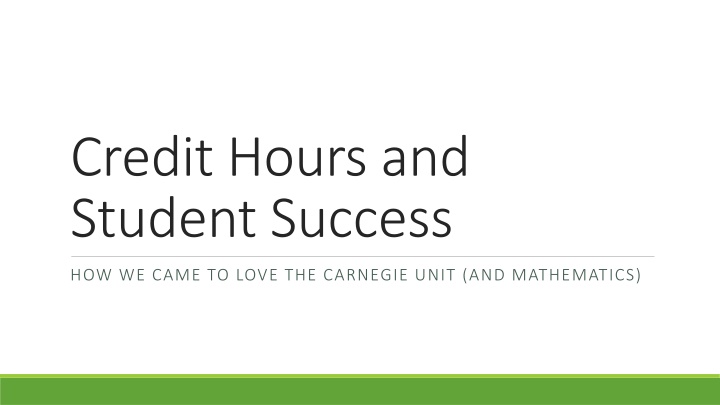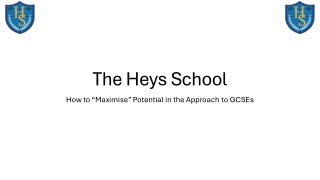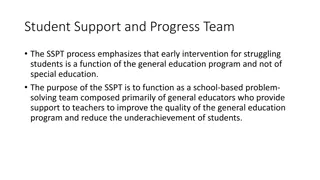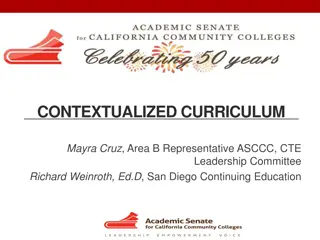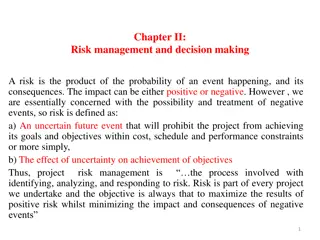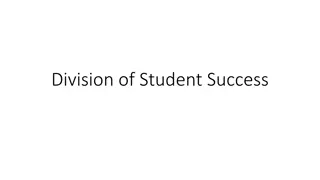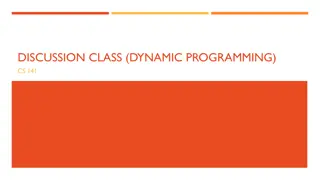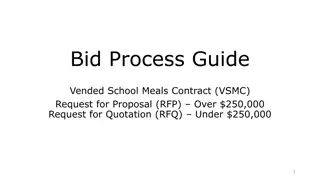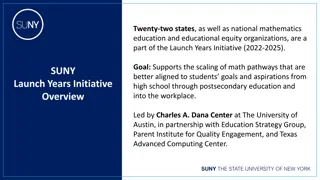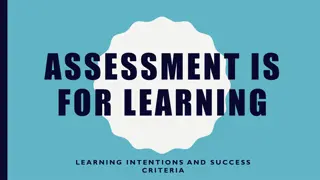Maximizing Student Success Through Effective Time Management
Understanding the importance of time in education, this article delves into how setting clear expectations, encouraging students to take time to learn, and utilizing the Carnegie Unit can improve student outcomes. Emphasizing the value of formative class time, the text highlights strategies to assist students in managing their time effectively for academic success.
Download Presentation

Please find below an Image/Link to download the presentation.
The content on the website is provided AS IS for your information and personal use only. It may not be sold, licensed, or shared on other websites without obtaining consent from the author.If you encounter any issues during the download, it is possible that the publisher has removed the file from their server.
You are allowed to download the files provided on this website for personal or commercial use, subject to the condition that they are used lawfully. All files are the property of their respective owners.
The content on the website is provided AS IS for your information and personal use only. It may not be sold, licensed, or shared on other websites without obtaining consent from the author.
E N D
Presentation Transcript
Credit Hours and Student Success HOW WE CAME TO LOVE THE CARNEGIE UNIT (AND MATHEMATICS)
Class time is formative. It enables students to gain specific insights into the world under the mentorship of experts. Every course is a vista point over a landscape that allows students to see their world differently. This is by its very nature particular --particular to the teacher, the text, the material and the student. These insights in turn form the lenses by which students view the world. They provide understanding, cultivate the imagination and are the basis for asking new, better questions. This all takes time. Students must have more than just competencies or skills --they must have the right kinds of intellectual experiences, whether we measure those experiences in terms of credits, tutorials, classes or some other unit. - JOHANN NEEM HTTPS://WWW.INSIDEHIGHERED.COM/VIEWS/2015/01/30/ESSAY-CONTINUING- IMPORTANCE-CARNEGIE-UNIT-ACADEMIC-CREDIT
Learning takes time HOW DO WE ENCOURAGE STUDENTS TO TAKE TIME TO LEARN?
Students have a better chance to succeed: When they understand what is expected of them When those expectations are realistic When they have access to the tools needed to meet those expectations When they receive timely feedback concerning their progress on meeting expectations When they have set aside the time to meet those expectations When they are motivated to prioritize the work When they show up for class, have read the material, and have completed the assignments
Setting Expectations of Time Help students manage their time Provide a clear picture of the time commitment needed to succeed Identify estimated time needed for major components of the course Clarify deadlines, and your policy regarding extensions, make-ups, alternate assignments, etc. Connect the dots between assignments, readings, homework and the learning outcome - help motivate students to see the value of time spent Let students know when feedback can be expected and how that feedback may impact upcoming work
Carnegie Units WHAT IS THE CARNEGIE UNIT? WHAT IS THE CARNEGIE UNIT? THE UNIT WAS DEVELOPED IN 1906 AS A MEASURE OF THE AMOUNT OF TIME A STUDENT HAS STUDIED A SUBJECT.
In class and outside of class Per ICCB Administrative Rules, students should expect to spend two hours of work outside of class for every lecture hour they spend in class regardless of the delivery method (online, hybrid, or on campus). They should expect to spend .5 hours of work outside of class for every lab hour they spend in class that means 1 hour for every two hours in lab Examples: 3 lecture hours 0 lab hours- 3 credit hours = 45 hours in class + 90 hours outside of class. 2 lecture hours 2 lab hours 3 credit hours = 30 lecture hours and 30 lab hours + 75 hours outside of class
Factors that impact time Page Density Text Difficulty Reading Purpose Complexity of Problems Level of comprehension, critical thinking or application of material you are seeking from the student Student s individual characteristics, prior experiences with similar material, grasp of foundational knowledge, motivation and commitment to learning, life
How fast does anyone read? Some sources calculate an average of 1.5 hours to read a 30 page chapter in the average textbook. Cornell University recommends that students multiply the number of pages by 5 to get the expected time it will take to preview, read actively, and review textbook material. https://www.cornellcollege.edu/academic-support-and-advising/academic- support/study-tips/reading-textbooks.shtml
Example of Workload Estimator https://cte.rice.edu/workload
Lecture Courses The following definitions will be used in determining the assignment of credit hours to a course. These definitions are based on the Federal Credit Hour definition and the ICCB System Rules, Section 1501.309. Lecture/discussion-oriented courses: One semester credit hour is assigned for every 15 classroom contact hours per semester. For each classroom contact hour, students should invest a minimum of two hours in outside-of-classroom study and relevant learning activities (ICCB).
Check the CIF to Confirm Credit Hours This is a 3-0-3 course 3 hours of lecture With no lab Total Credits: 3 3 lecture hour x 15 weeks = 45 hours in the classroom
Check the CIF to Confirm Clock Hours 3 credit hours: 45 contact hours (15 hours per credit)
Lecture Courses continued Think about your course What are the major components students will work on outside of class time? Are there components such as Discussion Posts, outside quizzes, reading assignments? Can you help students identify those components where time is best spent? All courses will not look alike on a template. Mainly, HLC will want to see documentation time and effort. XXX 123 Course Activities Expect to Spend Lecture Course 3-0-3 45 hours/ 3 hours week In class lecture Lecture Hours 45 hrs 30 hours/2 hours week Reading Assignments Outside Work 90 hrs 15 hours/ 1 hour week Total 135 hrs Homework 45 hours/ 3 hours week Studying/Test Prep 135 hours Total
Lab Courses Laboratory courses: One semester credit hour is assigned for every 30 to 35 classroom contact hours per semester. For every two laboratory contact hours, students should invest a minimum of one hour in outside-of-classroom study and relevant learning activities (ICCB). At Parkland College, when a course has 30-45 hours of lab time, it is one credit hour. If the course CIF is 30 contact hours, you should have one hour of outside work. If the course is 45 contact hours, then you do not have to document outside work.
Check the CIF to Confirm Credit Hours This is a 3-3-4 course 3 hours of lecture 3 hours of lab Total Credits: 4 Lab Hours: 2-3 Lab hours is one credit hour. 3 lecture credits + 1 lab credit = 4 credit hour course
Check the CIF to Confirm Clock Hours 3 credit hours: 45 contact hours (15 hours per credit) 2 credit hour of lab is 45 hours.
Lab Courses Continued Think about your lab course Is it hands on for the entire lab section? Do you have some downtime when students work on worksheets/readings? Do you give homework assignments specific to lab? All courses will not look alike on a template. Mainly, HLC will want to see documentation time and effort. XXX 123 Lab Course 0-3-1 XXX 123 Course 0-2-1 Lab sessions 45 hours/ 3 hours week Lab sessions 30 hours/2 hours week In class worksheets In class worksheets Homework No homework Homework 15 hours/1 hour week Total 55-60 hours per semester Total 45 hours
Clinical, Internship, or Practicum Courses Clinical Practicum courses: One semester credit hour is assigned for every 30-60 contact hours per semester. For every two practicum contact hours, students should invest a minimum of one hour in outside-of-classroom study and relevant learning activities (ICCB). Internship Courses: Courses in which students participate in nonclinical internship, practicum, or on-the-job supervised instruction shall receive one semester credit hour or equivalent for each 75-149 contact hours, at a minimum, per semester credit hour or equivalent (ICCB). At Parkland, the hour ratio for clinicals, internships, and practicums vary from course to course. Regardless of the ratio, there is a total number of hours listed on the CIF and students should be aware of the time they need to set aside for success in the course.
Internship Courses XXX 123 Internship 1-10-3 On-site 150 hours/10 hours per week Lecture 15 hours/ 1 hour per week Reading 30 hours/ 2 hours per week Total 195 hours/approx. 13 hours per week
Consider length of the course . If you teach a course in 13-week or 8-week formats you will need to calculate time accordingly. For example, students can expect to spend 5 - 6 hours per week working outside of class in a 16- week course. Double that for an 8-week course. If they take the course in a 13-week format they should expect to spend roughly 7 hours per week.
Expectations of HLC and ICCB Expectations of HLC and ICCB Assignment of Credits (HLC FDCR.A.10.020): Aninstitution shall be able to equate its learning experiences with semester or quarter credit hours using practices common to institutions of higher education, to justify the lengths of its programs in comparison to similar programs found in accredited institutions of higher education, and to justify any program-specific tuition in terms of program costs, program length, and program objectives. Affiliated institutions shall notify the Commission of any significant changes in the relationships among credits, program length, and tuition.
Higher Learning Commission Visit in 2022 Higher Learning Commission Visit in 2022 Parkland College will have an HLC visit in 2022. The HLC Peer Review Team may audit randomly chosen courses to see whether there is sufficient evidence in the syllabi that the credits that we charge students matches the amount of faculty initiated instruction and learning activities. Additionally, it is important at the start of each semester to know what to expect for the workload for the course: the amount of time for reading, studying and assignments. Students need to know how much time to set aside (Lau 2019).
Course Syllabi for Spring 2020 All syllabi should include a Carnegie Unit table. If you have already printed your syllabus, please post an addendum on Cobra and direct students to the information Consider spending just a portion of time in the first week of class to talk with your students about time management Check in with them throughout the semester to make certain they are mindful of the expectations When ever possible, give them a heads-up about assignments or sections of the course that might require more time than others help them plan ahead
Remind students that these are estimates of time Include a Syllabus Statement (above or below the table) The following table represents the expected course workload for this course. The times listed for readings and assignments are estimates and will vary from student to student.
Lets Review PLAY 101 - Philosophy of a Happy Childhood is a 1-5-3 class 1 hour in the classroom per week X 15 weeks = 15 hours 15 X 2 = 30 hours work to be expected outside class 5 hours in lab per week X 15 weeks = 75 hours 75 X .5 = 37.5 hours expected outside class PLAY 123 Course 1-5-3 XXX 123 Course 0-2-1 Lecture sessions 15 hours/ 1 hour per week Lab sessions 75 hours/5 hours per week General Tom-foolery 9 hours/ .6 hour per week Play Doh Sculptures 15 hours/ 1 hour per week Reading With Parents 12 hours/ .8 hour per week Testing Gravity Outdoors 22.5 hours/1.5 hours/week Silly Shenanigans 9 hours/ .6 hour per week Total 157.5 hrs/10.5 hrs/week
